
How to prevent tooth loss and implants: flossing can prevent implants
Oral health is fundamental to general well-being, and a frequent question when it comes to oral hygiene is: “Do I really need to floss?” The answer is an emphatic YES. In this article, we’ll explore why flossing is indispensable, especially to avoid serious consequences. In addition, we’ll show you how to prevent tooth loss and implants with simple care that can easily be included in your daily routine.
When did flossing begin?
Dental floss was invented at the beginning of the 19th century. The first reference to the use of a specific thread for cleaning between the teeth was made in 1819 by the dentist Levi Spear Parmly, a professional from New Orleans, United States. He recommended the use of a silk thread to remove food particles and plaque from between the teeth, a practice he considered essential for the prevention of oral diseases.
Despite this early recommendation, dental floss was not widely adopted immediately. The popularization of dental floss began to grow at the end of the 19th century, especially after the company Codman & Shurtleff began marketing unwaxed silk floss in 1882. However, it wasn’t until the 20th century, with the mass production of dental floss by companies such as Johnson & Johnson, that flossing became common practice around the world.
Johnson & Johnson was the first company to patent dental floss in 1898, and from then on, the practice began to spread more widely, especially as awareness of the importance of oral hygiene increased in the 20th century.
Therefore, if we look carefully, it is relatively recent for the general population to know how to properly clean their teeth. If we think back to a time not so long ago, great-grandparents were the generation who wore dentures because they had lost all their teeth. The next generation learned a little more about caring for teeth. However, it was only recently that this panorama began to change, and knowledge about how to prevent tooth loss and implants began to spread.
Below, we’ll discuss how simple care routines are crucial for preserving teeth and oral health. Follow along!
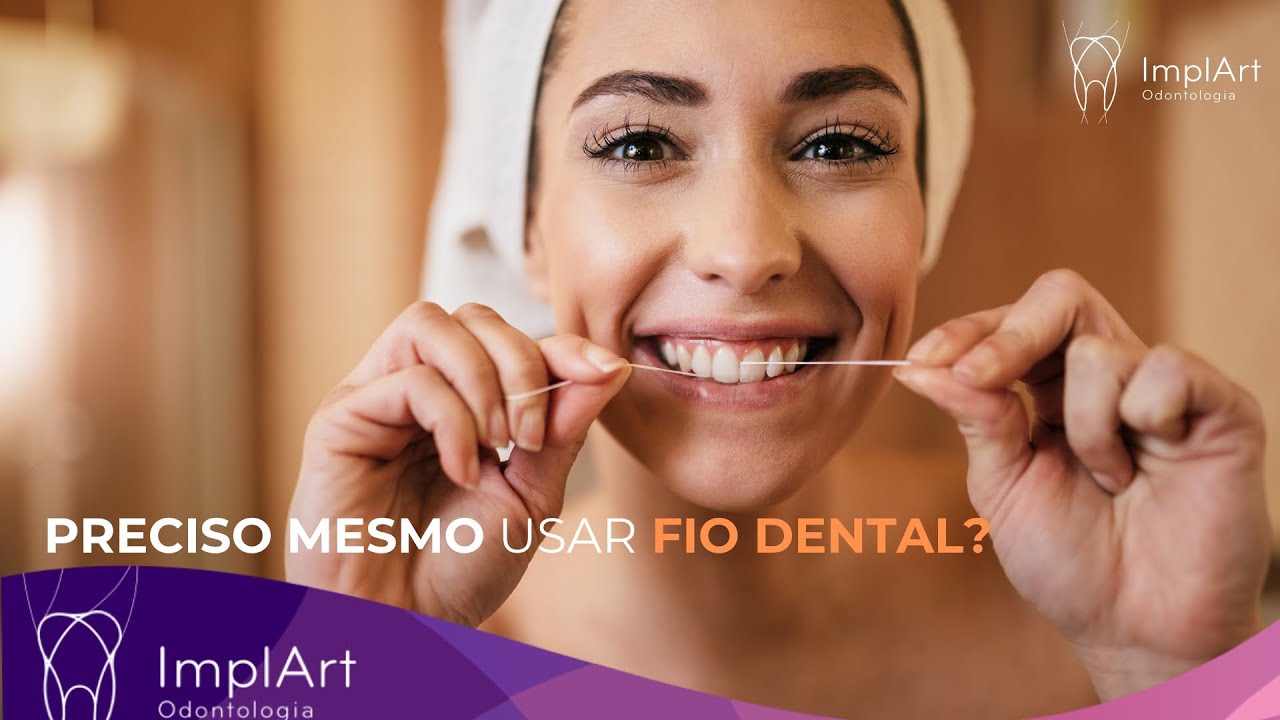
How to prevent tooth loss and implants: Learn about the benefits of flossing
Flossing is an essential tool for preventing oral problems which, if neglected, can result in tooth loss and the need for dental implants. In Brazil, where around 55% of the adult population has some degree of gum disease, according to the Ministry of Health, flossing makes all the difference. It removes food debris and plaque that the toothbrush cannot reach, especially in the interdental areas.
Flossing daily drastically reduces the risk of cavities and gingivitis, preventing problems that can lead to the need for dental implants. In addition, regular flossing contributes to fresher breath and healthier teeth, preventing the build-up of bacteria that can cause serious problems.
Consequences of Not Flossing: From the Risk of Gingivitis to the Need for Dental Implants
Neglecting to floss can have severe consequences, culminating in tooth loss and the need for implants. Without proper plaque removal, the build-up between teeth significantly increases the risk of gum disease. Studies in Brazil show that around 18% of adults have lost at least one tooth due to periodontitis, a condition that starts with untreated gingivitis and can progress to bone loss and, eventually, the need for dental implants.
*Read more about periodontal disease in implants: “Can implants get periodontal disease?“
Tooth loss is not only an aesthetic problem, but also a functional one. The absence of one or more teeth can impair chewing, speech and even the structure of the face. Regular flossing can prevent these problems and the need for more invasive procedures such as dental implants.
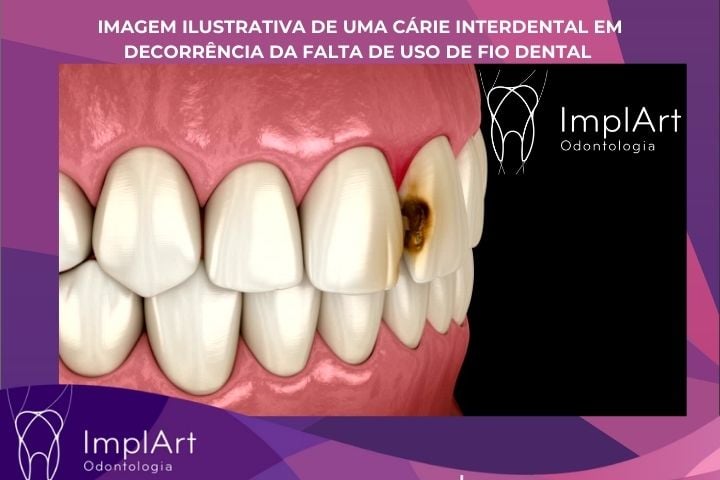
Historical Comparison: How Dental Floss Reduced the Need for Dental Implants in Brazil
Decades ago, oral health in Brazil was marked by high rates of tooth decay and tooth loss, often resulting in the need for dental implants. Before the popularization of dental floss, many Brazilians faced tooth loss at a young age. In the 1960s, for example, the average number of teeth lost per adult was alarming. With increased awareness and use of dental floss, these figures began to fall, also reducing the need for dental implants.
Recent IBGE data shows that total tooth loss in Brazilians over the age of 60 has fallen to less than 30% in recent years, a significant reduction compared to previous decades. This is largely due to increased education about oral hygiene, including flossing as a prevention against tooth loss and, consequently, the need for dental implants.
How to Floss Correctly
Flossing correctly is essential to ensure the effective removal of plaque and food debris from between the teeth, preventing problems such as cavities, gingivitis and, ultimately, the need for dental implants. Here’s a simple guide to doing it the right way:
- Cut the floss: Use about 40 to 50 cm of floss. This allows you to use a clean piece of floss in each interdental space.
- Wrap the thread: Wrap most of the thread around the middle finger of one hand and the rest around the middle finger of the other hand, leaving about 5 cm of thread between the fingers.
- Hold and position: Hold the floss firmly between your thumbs and index fingers, keeping it taut. Insert the floss gently between the teeth, using a sawing motion to prevent the floss from slipping and hurting the gums.
- C” motion: Curve the floss in a“ C” shape around a tooth, sliding it gently under the gum line. Run the floss up and down a few times to remove plaque and debris. Remember to also floss the side of the adjacent tooth.
- Repeat in each space: Use a clean piece of floss for each space between the teeth. Repeat the process on all the teeth, including the bottom teeth, which are harder to reach.
- Dispose of the floss: After finishing, dispose of the used floss. Never reuse the floss as it may already be contaminated with bacteria.
Here are some simple tips for flossing:
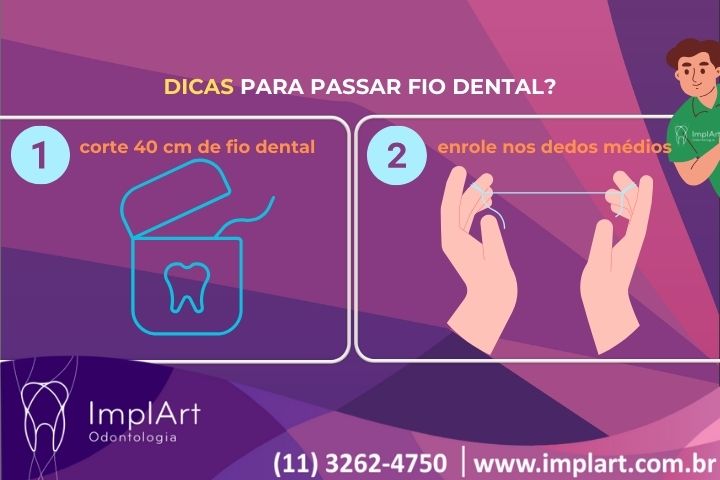
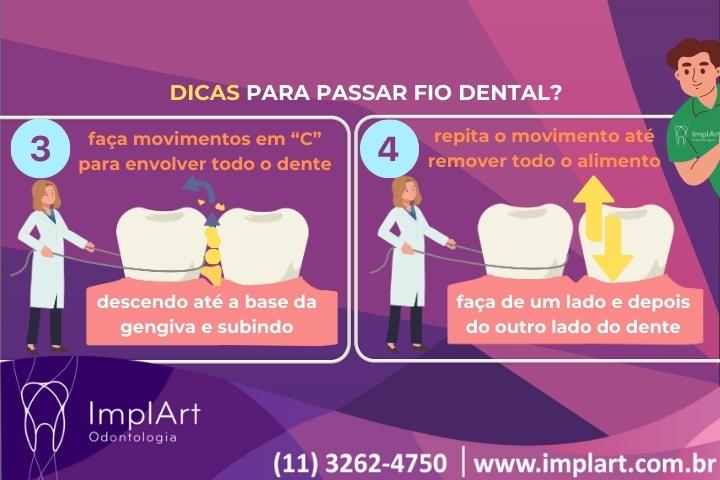
Following these steps helps ensure a thorough and effective cleaning, protecting your teeth and gums from future problems that could result in dental implants.
What are the effects of plaque caused by retained food?
Food that is trapped between the teeth can cause a series of oral problems due to the chemical and physical processes that occur over time. Here is a summary of the main effects:
1. Plaque build-up
When food debris is not removed, it accumulates between the teeth and serves as a source of nutrients for the bacteria in the mouth. These bacteria, mainly Streptococcus mutans, metabolize the carbohydrates in food, especially sugars and starches, to produce acids.
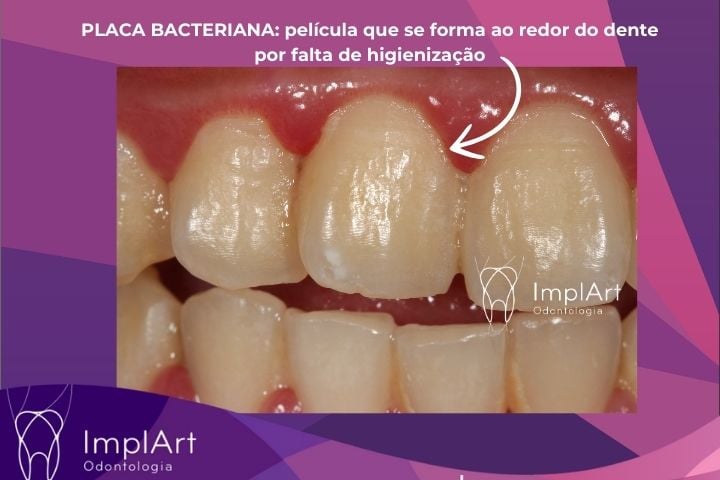
2. Acid production
The metabolization of carbohydrates by microorganisms results in the production of organic acids, such as lactic acid, which are highly corrosive. These acids begin to dissolve tooth enamel, which is the outer protective layer of teeth made up mainly of hydroxyapatite, a mineral rich in calcium and phosphate.
3. Enamel demineralization
Continuous exposure to acid causes enamel demineralization, a process in which minerals (calcium and phosphate) are removed from the surface of the tooth, weakening it. This process is the initial stage in the formation of cavities. If left untreated, demineralization can progress to dentin, the innermost layer of the tooth, which is less resistant to acidity.
4. Tooth decay
Over time, persistent demineralization can lead to the formation of cavities (caries) in the enamel. If the decay is left untreated, it can progress to the dentin and eventually reach the dental pulp, where the nerves and blood vessels are located. This can result in pain, infection and, in severe cases, the need for root canal treatment or tooth extraction and implantation.
*Read more about the importance of replacing lost teeth with implants: Tooth loss without implant replacement: what are the consequences?
5. Gingival inflammation
In addition to cavities, food debris and plaque that accumulate between the teeth can irritate the gums, leading to an inflammation known as gingivitis. If left untreated, gingivitis can develop into periodontitis, a more serious condition that affects the bone supporting the teeth and can result in tooth loss. Thus, if it progresses without care, it can lead to complete tooth loss and the need for a total implant with a prosthetic protocol.
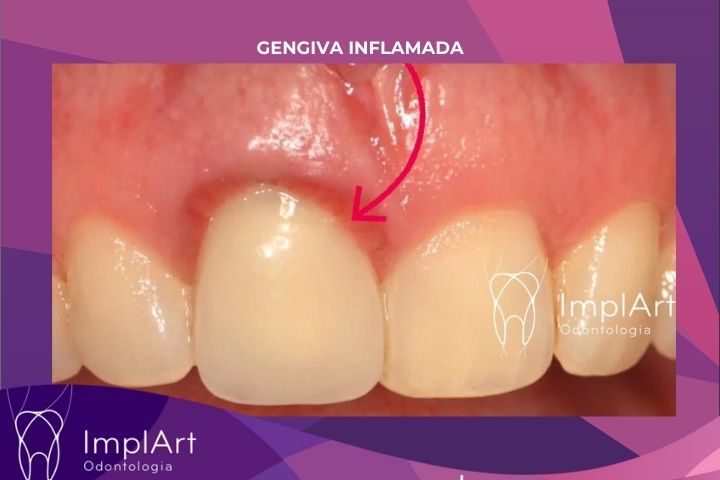
*Read more about the modern Zirconia protocol prosthesis: Zirconia is the most modern material for protocol prostheses on dental implants.
6. Halitosis (Bad Breath)
Food trapped between the teeth, when broken down by bacteria, releases volatile compounds such as hydrogen sulphide and methyl mercaptan, which are the main causes of bad breath.
7. Tartar formation
If plaque is not removed, it can mineralize and harden, forming tartar (dental calculus). Tartar is difficult to remove with ordinary brushing and can cause even more irritation to the gums, as well as providing a rough surface where more plaque can accumulate.
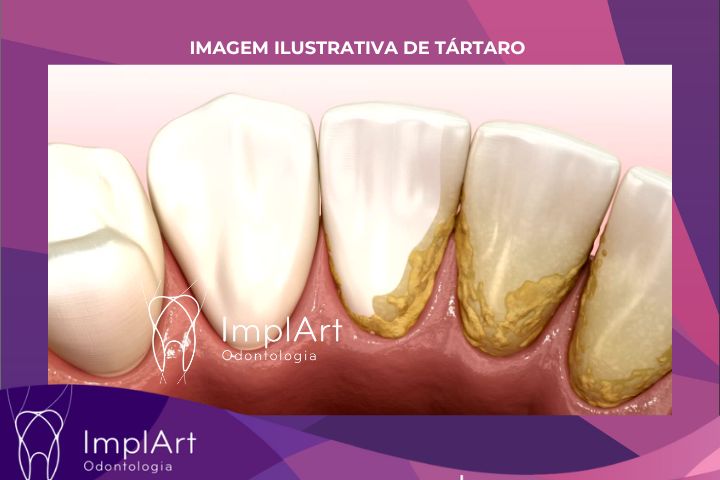
Therefore, food trapped between the teeth can trigger a series of harmful reactions that not only erode the teeth, but also affect the gums and breath, underlining the importance of regular flossing to prevent these problems.
In addition, we should mention the need to visit the dentist regularly for oral health monitoring appointments and dental cleanings.
*Readmore about the importance of cleaning at the dentist: “The importance of professional cleaning for the maintenance of dental implants, dentures and oral health”
Conclusion on how to prevent tooth loss and implants
Flossing is more than a recommendation: it’s a necessity for maintaining oral health and avoiding serious consequences such as tooth loss and the need for dental implants. By flossing daily, you can protect your smile and ensure a healthier life. Don’t put off until tomorrow what can be done today – start taking care of your oral future now with flossing and regular visits to the dentist!
*Read more about oral health care: “In the fever of facial harmonization, patients are forgetting to take care of their teeth“
What if there is tooth loss and implants are needed?
But don’t worry, if you need a dental implant, know that today’s techniques are very modern and there are several types of dental implant to choose from at the ImplArt Dental Clinic. Whether your treatment is an individual dental implant, or a total implant and prosthesis protocol, know that the ImplArt Clinic masters all dental implant and oral rehabilitation techniques, and surely one will be right for you!
Want to know more about ImplArt Clinic from Brazil?
Located in São Paulo, ImplArt Dental Clinic is a reference destination for patients from all over the world. Recognized as the best dental implant clinic in São Paulo, ImplArt stands out for its excellence in modern and personalized dental treatments.
Under the direction of Dr. Roberto Markarian (PhD), an implant dentist renowned for his expertise in dental implants and digital prostheses, the clinic combines advanced knowledge with high technology. This makes ImplArt a center of excellence in dental treatment, offering computerized implants and prostheses to guarantee the best results.
To find out more about the treatments offered by ImplArt Dental Clinic, visit our Instagram and check out the images of our treatments. Don’t forget to watch our videos on YouTube and explore our Pinterest page to see more examples of our work.
Check out the photo gallery of our treatments or contact us by WhatsApp (11) 3262-4750 to schedule your appointment.
Dr. Roberto Markarian, implant dentist
Text written by DR. ROBERTO MARKARIAN – CRO-SP 73.583
Founder and Director of the ImplArt Dental Clinic – Dr. Roberto’s Linkedin profile
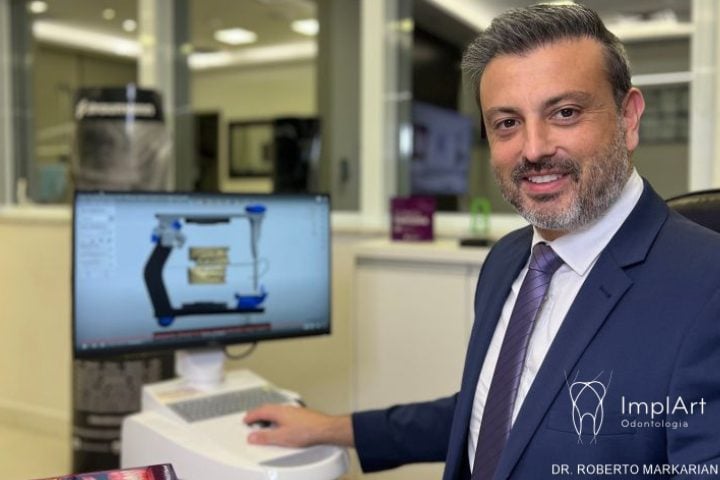
Dr. Roberto Markarian is a reference in dental implants and computerized dental prostheses in Brazil. As well as having more than 10,000 implants installed, he is a researcher who produces knowledge that is published worldwide in renowned scientific journals in the field of dentistry. He is responsible for promoting knowledge and high technology applied in all the treatments offered by the ImplArt Clinic.
schedule your appointment at the implart clinic by phone or whatsapp

📲(11) 3262-4750
📲WhatsApp(11) 3262-4750
Leave a Reply